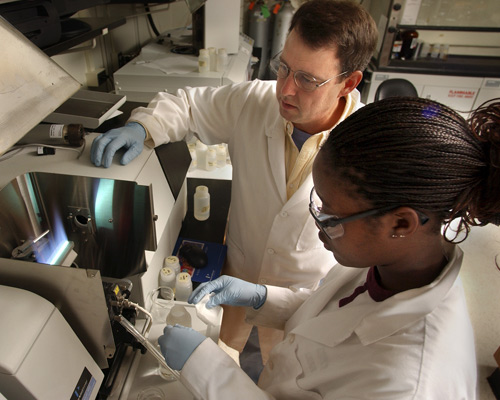The coloring in wastewater produced by the pulp and paper industry may not poison rivers outright, but it does make neighbors angry and life harder for water organisms by affecting light absorption.
That’s why a Lafayette College student is working hard to find an economical way to remove the coloring from the effluent of paper plants in research on campus this summer.
“The current method of removing the color is very expensive,” says Naa Quarcoo ’04. “And although there is no EPA regulation on the color, it affects the plants and animals in the water. So my research is about finding an economical method before there are die-outs in the area.”
Quarcoo has found two ways to remove the color, one of which is particularly promising, according to Javad Tavakoli, associate professor of chemical engineering, who is steering the EXCEL Scholar project. In Lafayette’s distinctive EXCEL program, students assist faculty members with research while earning a stipend.
“She’s solved the problem, and that’s the best thing you can say!” comments Tavakoli, who expects Quarcoo to continue working on it until the results are ready to present at a conference.
Quarcoo says the promising solution is activated charcoal, which absorbs the color without altering the chemical nature of the wastewater, although she is not sure why or which kind of charcoal works best.
“Charcoal is relatively cheap and can be used over and over again. It doesn’t lose its potency,” says the chemical engineering major. The second method she identified, after studying five or six techniques, is sodium percarbonic, which forms a sludge and may not work out as well.
Quarcoo began her project by making paper to find out which step of the process produces the color. “Most of the color comes from the pulp bleaching process,” she says, adding that the varied composition of the raw wood complicates any scientific solution.
The EXCEL work has been interesting, says the student, who expects to enter the research field for her career, although she wants to find new products for industry rather than studying wastewater.
“You get to learn a lot and get to know what your future’s going to be about,” Quarcoo says of EXCEL. “I can see that I’ll be spending a lot of my life in the lab.”
Tavakoli describes her as “very diligent in running her experiments” and is optimistic that one of her methods will be found acceptable by industry. “Naa has done a great job,” he professor adds.
A graduate of Achimoca School in Accra, Ghana, Quarcoo is vice president of the African and Caribbean Students Association, and a member of the International Students Association and the Lafayette Christian Fellowship. She works at Kirby Sports Center and in the chemical engineering department.

A National Leader in Undergraduate Research. Naa Quarcoo ’04 presented her collaborative research with Arthur Kney, asst. professor of civil and environmental engineering, at the American Institute of Chemical Engineers’ national meeting.
